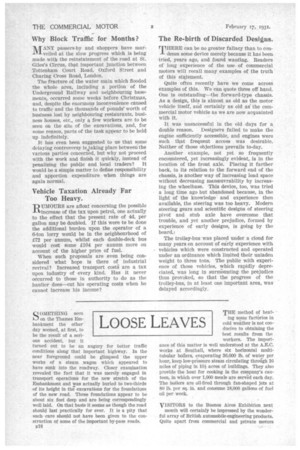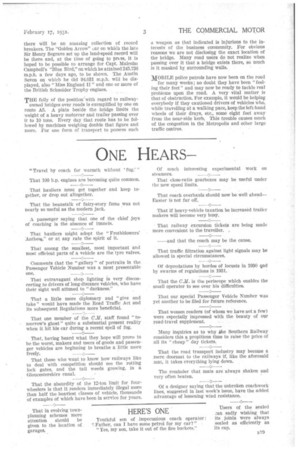LOOSE LEAVES
Page 46

Page 47

If you've noticed an error in this article please click here to report it so we can fix it.
S03/IETHING seen on the Thames Em bankment the other day seemed, at first, to be the result of a serious accident, but it turned out to be an augury for better traffic conditions along that important highway. In the near foreground could be glimpsed the upper works of a steam wagon which appeared to have sunk into the roadway. Closer examination revealed the fact that it was merely engaged in transport operations for the new stretch of the Embankment and was actually buried to two-thirds of its height in the excavations for the foundations of the new road. These foundations appear to be about six feet deep and are being correspondingly well laid. On that basis it seems as though the road should last practically for ever. It is a pity that such care should not have been given to the construction of some of the important by-pass roads. THE method of heat ing some factories in cold weather is not conducive to obtaining the best results from the workers. The importance of this matter is well understood at the A.E.C. works at Southall, where six horizontal multitubular boilers, evaporating 36,000 lb. of water per hour, keep low-piessure steam circulating throigh 16 miles of piping in 10,1 acres of buildings. They also provide the heat for cooking in the company's canteen, in which over 1,000 meals are served each day. The boilers are oil-fired through fan-shaped jets at 80 lb. per sq. in. and consume 18,000 gallons of fuel oil per week.
VISITORS to the Buenos Aires Exhibition next month will certainly be impressed by the wonderful array of British automobile-engineering products. Quite apart from commercial and private motors there will be an amazing collection of record breakers. The "Golden Arrow" ear on whi6h the late Sir Henry Segrave set up the land-speed record will be there and, at the time of going to press, it is hoped to be possible to arrange for Capt. Malcolm Campbell's "Blue Bird," on which he attained 245.736 m.p.h. a few days ago, to be shown. The Austin Seven on which he did 94.031 m.p.h. will be displayed, also "Miss England II" and one or more of the British Schneider Trophy engines.
THE folly of the position with regard to railway owned bridges over roads is exemplified by one on route A5. A plate beside the bridge limits the weight of a heavy motorcar and trailer passing over it to 10 tons. Every day that route has to be followed by machines weighing double that figure and more. For • one form of transport to possess such a weapon as that indicated is injurious to the interests of the business community. For obvious reasons we are not disclosing the exact location of the bridge. Many road users do not realize when passing over it that a bridge exists there, so much is it masked by surrounding walls.
MOBILE police patrols have now been on the road for many weeks; no doubt they have been "feeling their feet" and may now be ready to tackle real problems upon the road. A very vital matter is that of obstruction. For example, it would be helping everybody if they cautioned drivers of vehicles who, while travelling at a walking pace, keep the left-hand wheels of their drays, etc., some eight feet away from the near-side kerb. This trouble causes much of the congestion in the Metropolis and other large traffic centres.






















































































































